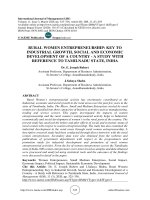Economic growth and economic development 565
Bạn đang xem bản rút gọn của tài liệu. Xem và tải ngay bản đầy đủ của tài liệu tại đây (138.55 KB, 1 trang )
Introduction to Modern Economic Growth
Now returning to the discussion in the previous subsection, we can also see that
trade secrecy or innovations that are specific only for the needs of the firm in question
will act in the same way as ex post patent protection in encouraging innovation (see
Exercise 12.5).
Note also that the expressions for πˆ I1 and π I1 in this proposition also give the
value of innovation to firm 1, since without innovation, it would make zero profits. Given this observation, we now contrast the value of innovation for firm 1 in
these two regimes with the social value of innovation, which is still given by (12.1).
Moreover, we can also compare social values in the equilibrium in which innovation
is undertaken by firm 1 (who will charge the profit-maximizing price) to the full
social value of innovation in (12.1), which applied when the product was priced at
marginal cost. The equilibrium social surplus in the two regimes (with monopoly
and limit pricing) can be computed as
(12.5)
¡ ¢¡
¢
Sb1I = D pM pM − λ−1 ψ +
λ−1
− µ.
λ
We then have the following result:
Z
ψ
pM
D (p) dp − µ, and
S1I = D (ψ) ψ
Proposition 12.2. We have that
π I1 < π
ˆ I1 < S I .
Proof. See Exercise 12.3.
S1I < Sb1I < S I .
Ô
This proposition states that the social value of innovation is always greater than
the private value in two senses. First, a social planner interested in maximizing
consumer and producer surplus will always be more willing to adopt an innovation,
because of an appropriability effect; the firm, even if it has ex post monopoly rights,
will be able to appropriate only a portion of the gain in consumer surplus created
by the better technology. Second, even conditional on innovation, the gain in social
surplus is always less in the equilibrium supported by ex post monopoly than the gain
that the social planner could have achieved (by also controlling prices). Therefore,
551









